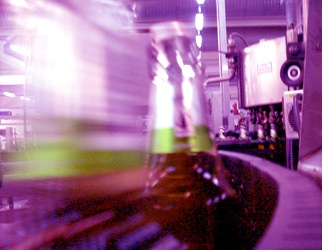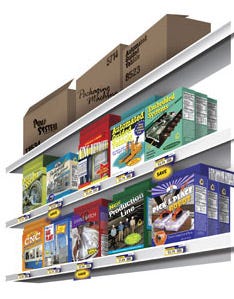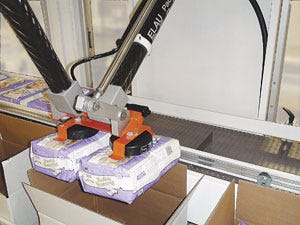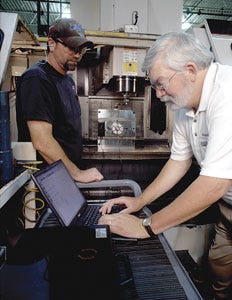March 11, 2015


Controller 6
Like the cereal aisle in the grocery store, the number of controller vendors and individual controller models available can present a daunting choice. Faced with so many options, many engineers simply go with what they or their predecessors have used previously. But that may not be the best choice for your application.So Control Engineering, a Packaging Digest sister publication, asked application engineers and other experts from a dozen controller vendors to offer some of their expertise regarding what application-specific controller features to look for.
Here's a taste of what they had to say, arranged by application type. Expanded essays and links to customer case histories and white papers that provide more detailed instruction can be found at www.controleng.com.
What type of packaging machine?
Packaging machines generally can be placed into three classifications: all mechanical (GEN I); hybrid servo and mechanical (GEN II); and all-electric driven machines with full-servo designs (GEN III).
Designed from the ground up around what servos and controls can do to electronically synchronize the entire machine without the need for a line shaft and complex fixed mechanical cams, GEN III machines are virtually all electronic. These machines have significantly fewer mechanical parts and greater functionality, such as running multiple products and supporting automated changeover.
The all-electric system typically runs at higher speeds and is responsible for electronic synchronization, complex camming, and high speed registration along with advanced high speed robotics capabilities. Therefore, it will require a faster controller (with a scan time of 50–100 µS) and very fast acting I/O—or, more likely, a motion control network to handle I/O update times.
Memory of 1 MB or more also may be required to handle various product recipes that can be run on an individual packaging line.
What is the application?
Food and beverage packaging applications fall into a set of broadly-defined types and subcategories. Form/fill/seal machines, for instance, can be vertical or horizontal machines. Cartoners can be continuous or intermittent motion style machines.

Controller 2
Each application and its variants have certain requirements that will dictate what type of controller is selected, based on the amount of I/O functions, connectivity, and complexity of advanced capabilities.What are connectivity considerations?
Connectivity can be for remote I/O between controllers or up to a Level II supervisory or a SCADA system. The decision on which network touse is predicated on personal preferences, customer specifications, availability of components, and regional concerns.
Controller to controller (C2C) communications can be accomplished through proprietary networks such as MelsecNet or DH+, or through open networks such as SERCOS II. Connection to SCADA usually requires Ethernet capability. Etherneth as emerged as a medium of choicefor remote I/O and C2C communications as well.
Is scalability important?
Scalability is the ability to move up or down a PLC product line to easily add or subtract functionality. Some vendors have different software and hardware form factors for their lower- and higher-end PLCs; others have a unified line of software and hardware products. Both approaches have advantages.
Bosch Rexroth is an example of a unified line: It can scale from a GEN I to a GEN III machine by adding motion and other advanced functionality without negating previous engineering efforts and hardware purchases.
What software and programming functionality is required?
A low-end GEN I machine will probably only require ladder logic; a GEN III cartoner running at a high speed, using registration and robotics, will require advanced robotic function blocks and path planner capabilities. For the latter, look for a controller vendor that provides templates and out-of-the-box functions, such as functions to accomplish certain tasks such as temperature control or running a rotary knife. They allow greater programmer freedom than templates.
Ted Thayer, automation systems product manager, Bosch Rexroth Electric Drives and Controls, www.boschrexroth-us.com
Automated guided vehicles
AGVs are often used to transport heavy loads or explore hazardous areas. The controller you choose should:
Be capable of running multiple PID loops, for speed control as well as steering. Using digital counting, a controller could determine rotation rate or “turnover” of the AGV's wheels as it ascends a hill. The controller then can compare that data to the figures taken when the vehicle travels on flat terrain. As the controller sees the count drop, it knows that the vehicle must be slowing down, and then will send a command to “throttle-up” or accelerate the AGV.
Be flexible in terms of its I/O and data handling capabilities. The controller/system chosen should be able to process signals from infrared, radar, proximity, and other sensors used to detect obstructions or path debris. This lets the AGV be programmed for collision avoidance.
Support wireless communications. A wireless controller eliminates the need to repeatedly physically connect the vehicle for data acquisition, debugging, and control program modifications. A wireless interface could also gather operational data (engine oil, air, and water temperature, battery charge, etc.) from vehicle components via sensors. Most such applications operate over wireless Ethernet (wireless LAN or Wi-Fi), but use of wireless wide area networks (WWAN or cellular) is growing.
David Crump, marketing communications manager, Opto 22, www.opto22.com
Pick-and-place robots
A trend exists among machine builders—particularly within packaging and food processing industries—to embed robotic pick-and-place functionality into their machine designs rather than integrate stand-alone robots. A controller employing advanced mathematical algorithms is key to smoothly coordinating the robot's motion. Also consider:
Processor power. A controller that can run multiple robots as well as the other motion and logic functions of a packaging machine in a single program on a single processor is ideal. This eliminates the cost of a separate robot controller without resorting to multiple CPUs. In some cases, the entire control program can execute in the processor's cache memory to maximize program execution speed.
Tool center point functionality. Tool center point (TCP) represents a fundamental distinction between machine and robotic motion. In machines, motions are defined as a set of trajectories for each servo axis. Compared to robots, only simple kinematics are available. In robots, motions are related to the TCP and not to individual axes. Motions are defined by the target position and type of movement of the robot. The required trajectories for each motor must be calculated.
Kinematics. The Schneider Electric robotic software library has a tool to perform complex control calculations automatically. The engineer can program cartesian motion just as he or she would for a conventional machine into an IEC 61131-3 conforming function block. Then a transformation function block performs all necessary kinematics, including true interpolation.
Additional features. A geometrical blending capability reduces cycle times by “blending” the path to optimize speed and distance traveled to reach the target point. Because robots can develop some G forces and too much can overcome a gripper's holding force on a product, look for intelligent acceleration monitoring.
Joe Krogman, project manager, Schneider Electric ELAU Packaging Solutions, www.elau.com
Pump system

Controller 3
For pumping systems, use alternating relays as level controllers. Typically used in applications where the optimization of load usage is required, alternating relays equalize the run time of two loads through the use of control switches (float switch, manual switch, timing relay, pressure switch, etc.). Each time the initiating switch is opened, the output relay contacts change state, thereby alternating the two loads. Also, in the case of excess load requirements, an alternating relay can be used to add capacity. The control of multiple pumps also can be handled through use of alternating relays. Typical control methods include:Simple alternator. This allows for the alternation of pumps to equalize wear. In a duplex or two-pump example, the first pump starts and runs; when the first pump stops, a second pump is selected for the next run-cycle. Alternators are available for duplex (two-pump), triplex (three-pump), and quadruplex (four-pump) operation.
Lead-lag operation. This method involves the selection of a primary or “lead” pump, and a secondary or “lag” pump to accommodate additional capacity. The pumps alternate; if additional capacity is not needed, the lag pump does not run but alternating action still occurs.
Designed for use in multiple load, triplexor and quadruplexor applications, alternating relays can perform both simple alternator and lead-lag operations. Control inputs can consist of floats or switches. Once the mode(s) of operation, control voltage, and the number of pumps are understood, selecting the appropriate controller is a matter of comparing the requirements to available pump controllers.
David Bredhold, MS, application engineer, Eaton Corp., http://budurl.com/EatonPumpPanels
New production line
Selecting a controller for discrete factory automation traditionally starts with an I/O list of signal types and specifications. This list includes voltage, current and any specialty interfaces for safety, motion control, high-speed counting, temperature or smart devices. Next come other system attributes, including distributed networked I/O modules to reduce wiring and conduit, support for built-in software functionality to reduce programming time, and business system connectivity for production reporting.
Typical factory transfer lines and related production applications benefit from choosing an automation controller family that has a common engineering software framework that can accommodate system expansion over time.
Siemens Simatic S7 product line, for example, includes a variety of controllers for small, large, PC-based, distributed, embedded, and machine-mount use (no enclosure required), and are all programmed with Step 7 engineering software. With such a controller, production line equipment that remains physically unchanged for more than 10 years can be upgraded to increase efficiency and add specialty functions, such as integrated safety, within the controller.
This type of foresight into controller selection can be a competitive advantage, as demonstrated by the new production line put in at the Southland Tube steel mill.
The company chose a Siemens Simatic S7-400 controller with distributed ET200 I/O on Profibus and Profinet communications connecting networked drives and motor starters. This controller architecture (Siemens Totally Integrated Automation), and WinCC visualization software for the SCADA control room, saved significant time and money during engineering and startup. The controller choice provided the processing power and device network connectivity to automate more than 30 drives and 300 motors. With all controller, I/O, and smart devices sharing the same software framework, Southland gained tools for configuration, diagnostics, and commissioning. Such an application could not be accomplished by combining many smaller standalone controllers.
Paul Ruland, Automation & Motion Division, Siemens Energy & Automation, Inc., www.sea.siemens.com
CNC machine tool
Engineers concerned with finding that controller “sweet spot” are trying to balance performance with budget. Also, the right controller isn't going to stay right forever, so they need flexibility to move as applications evolve and new markets are entered. Kays Engineering chose CX9010 and CX1010 Embedded PCs from Beckhoff Automation to control its CNC machine tools, partially so Kays can migrate to more powerful controllers as drilling technology evolves. Other considerations:
Processors & networks. Beckhoff's CX PAC line, for example, starts at the Intel IXP420 XScale 266 MHz processor level and allows continuous upward migration to Intel Pentium M CPU, 1.8 GHz processors. As technology advances, the controller vendor also should incorporate new technology, such as energy-saving Intel Atom processors.
The processor also must be capable of handling the specific program software. Kays' EtherCAT-based motion system provides optimum speed and position control of the machine tool's axis slide.
Software. The software should support variants for machine tools, e.g., NC PTP, NC I and CNC editions. It also should include time-saving features for frequently used functions such as code libraries, 3D interpolation, flying saw, camming, electronic gearing. Whatever the application, it also should help optimize programming, add functionality, save engineering time, and help eliminate expensive mechanical and electronic components.
Corey McAtee, product manager, Beckhoff Automation, www.beckhoffautomation.com

Controller 4
Simple batch applications

Controller 4
For simple batch applications, just about any controller will do and just about any programming language is applicable—if the process never changes. A batch process, however, rarely remains static, and that's the key factor engineers should keep in mind when selecting a controller.
In many batch processes, there are benefits to executing unit procedures directly in a controller: Reduced complexity; or improved availability; or speed of execution.
Select a controller that: 1) allows for increased batch execution availability by executing a complete single-unit procedure in a redundant controller; 2) increases throughput by reducing batch execution times and latency between application levels; and 3) offers improved operator usability through display integration and interactive instructions.
A process controller (or two) should be used, however, if the process expands and execution directly in the controller is not possible due to the size of the operation. Peer-to-peer communication between controllers allows for building a larger process.
Select a control environment that hosts all four levels of the ISA88 procedural model—procedure, unit procedure, operation, and phase—and supports online modifications for all elements of the batch automation solution. This means all four levels are authored and maintained in the same tool so users can change one element of logic, download it and track a version change for just that modified element. There's no need to increment the version of the entire batch automation strategy.
Joe Bastone, Honeywell Process Solutions, www.honeywell.com/sites/acs
CNC machine retrofit
A CNC retrofit typically upgrades the CNC, the servo motors and drives, the spindle motor and drives, and a portion of the associated wiring and related electromechanical components. Unlike rebuilding and remanufacturing, a CNC retrofit does not include any major repairs to the machine mechanics. Consider the following:
Error-proofing with custom macros. The flexibility required for high-mix manufacturing implies a level of programmability and, in fact, most CNCs incorporate some form of parametric programming. GE Fanuc calls this part programming feature Custom Macro B, and it is available on all current and many legacy controls.
Machine tool probing. Manufacturers get concerned about the time required for machine tool probe cycles, but the truth is that they are faster and more accurate than an operator can be. They are consistent, eliminating operator measurement and data-entry time variation for a predictable task time. Add a machine tool probe system during a retrofit, or at least choose a controller that makes the machine probe-ready.
Expanded part program memory. CNC part program memory space has traditionally been very limited, either by technology or cost. GE Fanuc controllers support a data server, which combines the features of Ethernet communications and a very large part-program storage location. The approved, high-speed flash memory card for the data server can handle up to 1 GB of part programs.
Maintenance training. Machine crashes related to setup errors remain a source of downtime, so automate and error-proof as much of the process as possible. Controller diagnostic tools let operators troubleshoot and recover quickly when a problem occurs; for example, diagnostics pages can provide a single, convenient location to monitor the status of the CNC, servo, and spindle systems.
Remote diagnostics, backup and restore
An Ethernet port can enable maintenance and industrial engineers remotely diagnose problems using a tool such as GE Fanuc's CNC Screen Display Function. Some CNC controllers incorporate automatic backup of files to flash memory, for one level of data security; GE Fanuc also offers Proficy Change Management for CNC.
Mark Brownhill, GE Fanuc CNC,www.gefanuc.com/products/family/cnc. A full white paper from GE about what to consider when doing a CNC retrofit is available at the Control Engineering Resource Center at http://controleng.resourcecenteronline.com.
About the Author(s)
You May Also Like


